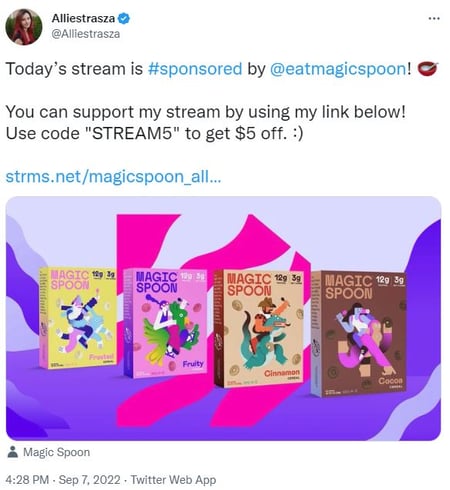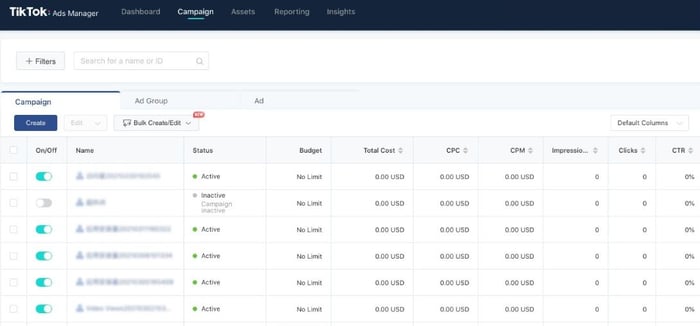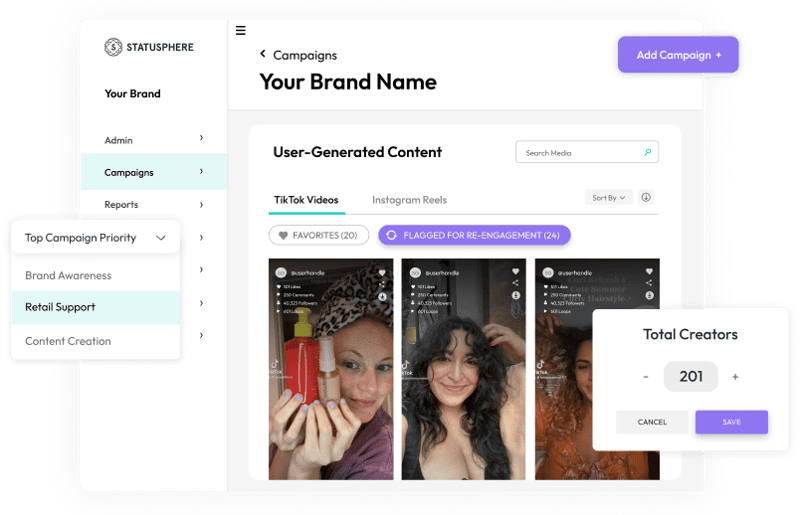
“Is it possible to track sales from influencers?”
We get asked this all the time. It’s a good question, too!
Because scoring sales is an understandable goal for brands running creator campaigns.
That’s kind of the endgame of any marketing campaign, right? Influencers are no exception.
Thing is, assessing the ROI of influencers is an oft-cited struggle for brands. This is especially true if you want to measure direct sales from individual creators.
This post breaks down the basics of tracking influencer sales including…
- How brands can monitor sales activity from social posts
- The challenge of tying influencer performance directly to sales
- The true sales impact of influencers beyond conversions
3 Common Methods for Tracking Influencer Sales
We recommend brands view sales as a welcome byproduct of always-on creator campaigns.
But let’s say you or your team are laser-focused on dollars and cents.
Fair enough! Below is a breakdown of how to track influencer marketing sales and conversions.
1. Affiliate Links
Affiliate programs aren’t exactly breaking news. Still, they’re still popular among brands.
The concept of affiliate links is simple enough:
- Brands provide creators with a unique, trackable promo link
- Creators then promote their links through their social media posts and bios
- When someone clicks the link, purchases completed within a specific time period are credited to the creator (who earns a commission)

Source: Twitter
These days, affiliate links are most common on platforms like Twitter or Facebook. That’s because you can’t actually put live links in your Instagram or TikTok posts. That said, you can still attribute sales made through affiliate links in your social bios.
How these links work isn’t one-size-fits-all. For example, Amazon influencers’ affiliate links are only active for a 24-hour period. If someone makes a purchase after the link expires, the sale isn’t tracked. Some affiliate programs offer long-term links (think: ~30 days).
There are a few ways to set up affiliate links to track sales from influencers like:
- Social landing pages (such as Like2Buy or Linkin.bio). These tools essentially generate trackable promotional links and individual landing pages for influencers.
- Platform-generated affiliate links. For example, Shopify hosts a variety of third-party apps to generate trackable links. This includes URL shorteners like Shortly and Short Link.
- Setting up UTM parameters. This requires some technical know-how but serves as an evergreen way to monitor influencer sales. In short, you can set up conversion events in Google Analytics (see below). Tagging individual influencers, you can see whether visitors from their links convert on-site.

Source: Google
2. Promo Codes
Promo codes basically work as affiliate links do.
But unlike links, promo codes can feature in captions across all social platforms.
Influencer codes are common among brand affiliates and ambassadors alike. These codes are typically a variation of the creator’s @handle. Platforms like Shopify have native tools to generate codes for each of your creators.
Let’s quickly break down what promo codes look like in the wild. To kick things off, influencers promote a product in a post and share their code as a sort of call-to-action.

Source: @emamm55
Many influencers have a hybrid affiliate link and code to promote across social. You can often find creators’ both types of affiliate offers in their bio link(s).

From here, you can tap through their links or redeem their code on-site. This gives shoppers some flexibility when using a creator’s discount.

3. Influencer Whitelisting/Allowlisting and Creator Ads
This is arguably the “easiest” way to track sales from influencer marketing directly.
By running creator content as ads, you own your campaign performance data. This includes clicks and conversions. Granted you set up retargeting and tracking pixels to monitor actions beyond social. For reference, here's a snapshot of TikTok's Ads Manager.

Source: TikTok
Below are a few options brands have for creator-based ads:
The Challenges of Tracking Sales from Influencers
We get it: you want a clear link between influencer performance and sales performance.
But creating that connection is easier said than done.
Why? Consumer behavior trends and ongoing privacy updates are making marketing attribution complicated. Below we break down why it’s such a struggle to track influencer content for sales.
Attribution Isn’t Always Accurate for Promo Codes or Links
Third-party codes often result in an incomplete view of influencer performance. Here’s why:
- Conversion data doesn’t track consumers that browse now but buy later. Translation: there’s not always a straight line from an influencer’s post to the checkout screen. The modern buyer's journey involves bouncing between social apps, review sites and more. Influencers quite literally influence purchasing decisions. Consumer touchpoints don’t always translate into link taps or promo code redemptions.
- Tracking links have a limited lifespan. Consider situations where products go viral weeks (or even months!) after an influencer’s initial post. By then, there's a good chance their promo link is either expired or unavailable. Popular coupon aggregators (like Honey) can override influencer promo codes, too. This leads to situations where consumers think they’re redeeming an influencer’s discount but aren’t. Either way, performance data is skewed.
- Privacy updates including those to iOS and Android limit conversion tracking. No surprises here. Trying to track influencer posting won’t get easier with a “cookieless future” looming. This speaks to the value of first-party influencer data versus relying on links or codes.
Social Algorithms Don’t Favor External Links
Social marketing often feels like a tug-of-war with the various algorithms, right?
The Instagram algorithm is notorious for boosting or burying posts. Posts that the algorithm deems too “salesy” often earn little engagement or reach. The list goes on and on.
Anecdotally, we’ve seen creators (outside of our network!) with 100,000+ followers get single-digit engagement on a promo code post.
Yikes.
Like it or not, social algorithms are getting smarter. Specific words and phrases can serve as red flags for posts that push promotions too hard. This trend has direct implications for brands trying to track influencer sales.
An independent study from Social Insider notes that IG posts containing “Link in Bio” underperform versus those that don’t. This illustrates the value of smaller creators that know how to promote products organically.
Many Influencers Don’t Want to Post Promo Codes
Skilled creators can seamlessly weave promotions into their posts.
But in some cases, affiliate links and codes put influencers at a disadvantage.
How so? New research says that links are the least-engaging type of social content. Heavy-handed product mentions also make posts feel less authentic.
This serves as a lose-lose situation for creators and brands alike. For creators, links and codes can compromise creativity and personality. This leads to less engagement. As a result, campaign performance suffers for the brand.
Our take? Creators know best! Influencers should have the creative freedom to promote products without sacrificing their voice or enthusiasm.
Understanding the True Sales Impact of Influencer Marketing
The key takeaway from all of the above?
Measuring direct from influencers is tricky. It isn’t getting any easier.
Still, the sales impact of influencers is well-documented. Food for thought: brand awareness is the top goal of brands running influencer marketing campaigns.
That’s because there is a measurable correlation between building awareness and driving sales.
Figuring out how to track influencer sales means looking at your entire funnel. In our experience, brands that run long-term campaigns see the best results. That’s because they’re able to build momentum via ongoing awareness and new creator content.
Beyond direct sales, note how else influencers impact sales in ways that are totally trackable:
- Influencers can serve as the source for your top-performing ads. Again, the popularity of creator-based ads and influencer allowlisting speaks for itself. Meta notes that campaigns featuring creators see a 15% increase in return on ad spend.
- Increasing your conversions on-site. Research says that conversions lift by 91% when shoppers engage with UGC. This includes content sourced from influencers (think: photos, videos, reviews). Featuring creator content on-site goes hand in hand with increasing your average order value.
- Earning brands more positive reviews Keep in mind that there’s a connection between positive reviews and more conversions. When you have an army of creators singing your praises, earning those reviews is much easier than it would be organically. The key is having a high volume of creators (think: hundreds, not a handful) to make sure your voice is head.
If you want to see the sales impact of influencers, look no further than the glowing comment section of a creator-based post like the one below.


Source: @curlsmith_official
Building awareness via creators fosters brand loyalty. That’s why brands from CPG to beauty and beyond are making influencers a top priority.
How to Track Influencer Marketing Sales Accurately and Effectively
There’s so much that goes into defining the “success” of an influencer campaign.
And of course, brands want to see sales from their campaigns.
Again, sales are a welcome byproduct of a thoughtful, always-on influencer strategy. The key is working with the right creators at scale and reporting on metrics that align with your goals.
And if you need help in either of these departments, Statusphere has you covered.
Our micro-influencer marketing platform optimizes your campaign ROI faster thanks to our matchmaking algorithm, fulfillment technology and creator community.
With Statusphere, brands are programmatically matched with vetted influencers that post guaranteed, rights-ready content. This includes content you can repurpose in ads and track future sales from. We've helped 400+ brands generate 75,000+ pieces of authentic content.

Want to learn more about our platform? Get in touch with one of our experts to see how our software can scale your micro-influencer marketing efforts in a fraction of the time.
This article was first published in December 2022. It was last updated June 21, 2023.
